The Fangcang hospital on Tsing Yi Island begins operation today. It’s the first of nine community isolation and treatment facilities built with mainland expertise to help Hong Kong fight the raging fifth wave of the COVID-19 pandemic. When in full operation, the facilities will provide a total of 50,000 units. China Daily photographer Edmond Tang took first-hand shots of the facility on Saturday.
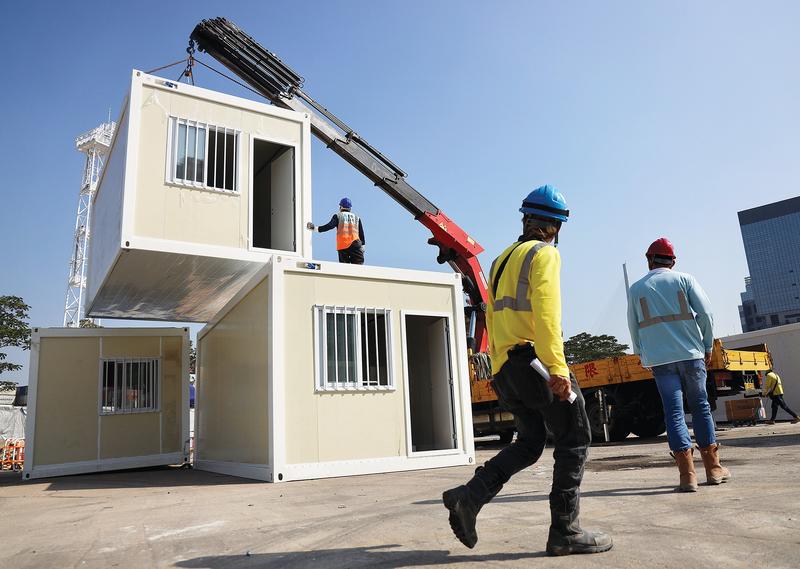 Workers putting the isolation units in place. (EDMOND TANG / CHINA DAILY)
Workers putting the isolation units in place. (EDMOND TANG / CHINA DAILY)
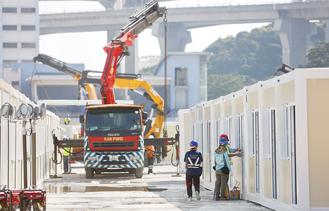 Construction work on the Tsing Yi site is undertaken by China State Construction International. (EDMOND TANG / CHINA DAILY)
Construction work on the Tsing Yi site is undertaken by China State Construction International. (EDMOND TANG / CHINA DAILY)
 Workers are subject to strict anti-pandemic measures, such as wearing masks and undergoing daily COVID-19 tests. (EDMOND TANG / CHINA DAILY)
Workers are subject to strict anti-pandemic measures, such as wearing masks and undergoing daily COVID-19 tests. (EDMOND TANG / CHINA DAILY)
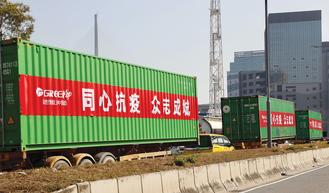 Huge signs on trucks bearing the isolation units read: “Together we fight the virus. Unity is strength.” (EDMOND TANG / CHINA DAILY)
Huge signs on trucks bearing the isolation units read: “Together we fight the virus. Unity is strength.” (EDMOND TANG / CHINA DAILY)
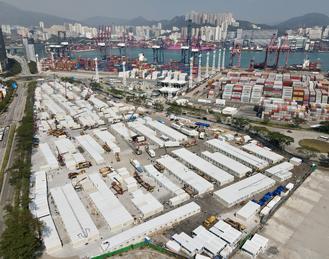 An aerial view of the Fangcang hospital site on Tsing Yi Island. The facility, covering an area of 60,000 square meters, offers 3,800 beds. The Hong Kong government had put up the site for sale by tender before deciding to use it to build the temporary hospital. (EDMOND TANG / CHINA DAILY)
An aerial view of the Fangcang hospital site on Tsing Yi Island. The facility, covering an area of 60,000 square meters, offers 3,800 beds. The Hong Kong government had put up the site for sale by tender before deciding to use it to build the temporary hospital. (EDMOND TANG / CHINA DAILY)
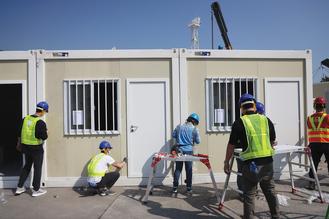 Workers expeditiously set up the isolation units. The mobile cabin units will house non-critical COVID-19 patients to help ease the strain on local hospitals, reduce delayed admissions and avoid the risks of spreading the virus through home quarantine. The model was adopted in Wuhan, Hubei province, to deal with the COVID-19 outbreak in early 2020. (EDMOND TANG / CHINA DAILY)
Workers expeditiously set up the isolation units. The mobile cabin units will house non-critical COVID-19 patients to help ease the strain on local hospitals, reduce delayed admissions and avoid the risks of spreading the virus through home quarantine. The model was adopted in Wuhan, Hubei province, to deal with the COVID-19 outbreak in early 2020. (EDMOND TANG / CHINA DAILY)
 Workers expeditiously set up the isolation units. The mobile cabin units will house non-critical COVID-19 patients to help ease the strain on local hospitals, reduce delayed admissions and avoid the risks of spreading the virus through home quarantine. The model was adopted in Wuhan, Hubei province, to deal with the COVID-19 outbreak in early 2020. (EDMOND TANG / CHINA DAILY)
Workers expeditiously set up the isolation units. The mobile cabin units will house non-critical COVID-19 patients to help ease the strain on local hospitals, reduce delayed admissions and avoid the risks of spreading the virus through home quarantine. The model was adopted in Wuhan, Hubei province, to deal with the COVID-19 outbreak in early 2020. (EDMOND TANG / CHINA DAILY)
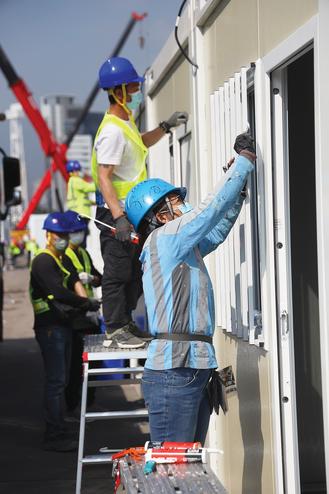 Workers expeditiously set up the isolation units. The mobile cabin units will house non-critical COVID-19 patients to help ease the strain on local hospitals, reduce delayed admissions and avoid the risks of spreading the virus through home quarantine. The model was adopted in Wuhan, Hubei province, to deal with the COVID-19 outbreak in early 2020. (EDMOND TANG / CHINA DAILY)
Workers expeditiously set up the isolation units. The mobile cabin units will house non-critical COVID-19 patients to help ease the strain on local hospitals, reduce delayed admissions and avoid the risks of spreading the virus through home quarantine. The model was adopted in Wuhan, Hubei province, to deal with the COVID-19 outbreak in early 2020. (EDMOND TANG / CHINA DAILY)


